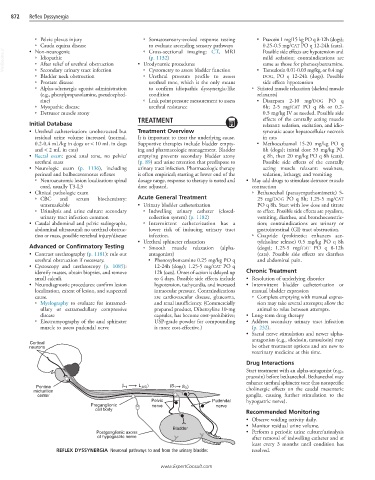Page 1737 - Cote clinical veterinary advisor dogs and cats 4th
P. 1737
872 Reflex Dyssynergia
○ Pelvic plexus injury ○ Somatosensory-evoked response testing ■ Prazosin 1 mg/15 kg PO q 8-12h (dogs);
○ Cauda equina disease ○ Cross-sectional imaging: CT, MRI 0.25-0.5 mg/CAT PO q 12-24h (cats).
to evaluate ascending sensory pathways
VetBooks.ir ○ Idiopathic • Urodynamic procedures mild sedation; contraindications are
Possible side effects are hypotension and
• Non-neurogenic
(p. 1132)
○ After relief of urethral obstruction
same as those for phenoxybenzamine.
○ Secondary urinary tract infection
DOG, PO q 12-24h (dogs). Possible
○ Urethral pressure profile to assess
○ Bladder neck obstruction ○ Cystometry to assess bladder function ■ Tamsulosin 0.01-0.03 mg/kg, or 0.4 mg/
○ Prostate disease urethral tone, which is the only means side effect: hypotension
○ Alpha-adrenergic agonist administration to confirm idiopathic dyssynergia-like ○ Striated muscle relaxation (skeletal muscle
(e.g., phenylpropanolamine, pseudoephed- condition relaxants)
rine) ○ Leak point pressure measurement to assess ■ Diazepam 2-10 mg/DOG PO q
○ Myopathic disease urethral resistance 8h; 2-5 mg/CAT PO q 8h or 0.2-
○ Detrusor muscle atony 0.5 mg/kg IV as needed. Possible side
TREATMENT effects of the centrally acting muscle
Initial Database relaxant: sedation, excitation, and idio-
• Urethral catheterization: unobstructed but Treatment Overview syncratic acute hepatocellular necrosis
residual urine volume increased (normal, It is important to treat the underlying cause. in cats
0.2-0.4 mL/kg in dogs or < 10 mL in dogs Supportive therapies include bladder empty- ■ Methocarbamol 15-20 mg/kg PO q
and < 2 mL in cats) ing and pharmacologic management. Bladder 8h (dogs); initial dose 33 mg/kg PO
• Rectal exam: good anal tone, no pelvic/ emptying prevents secondary bladder atony q 8h, then 20 mg/kg PO q 8h (cats).
urethral mass (p. 89) and urine retention that predispose to Possible side effects of the centrally
• Neurologic exam (p. 1136), including urinary tract infection. Pharmacologic therapy acting muscle relaxant: weakness,
perineal and bulbocavernosus reflexes is often empirical; starting at lower end of the sedation, lethargy, and vomiting
○ Neuroanatomic lesion localization: spinal dosage range, response to therapy is noted and • May add drugs to stimulate detrusor muscle
cord, usually T3-L3 dose adjusted. contraction
• Clinical pathologic exam ○ Bethanechol (parasympathomimetic) 5-
○ CBC and serum biochemistry: Acute General Treatment 25 mg/DOG PO q 8h; 1.25-5 mg/CAT
unremarkable • Urinary bladder catheterization PO q 8h. Start with low dose and titrate
○ Urinalysis and urine culture: secondary ○ Indwelling urinary catheter (closed- to effect. Possible side effects are ptyalism,
urinary tract infection common collection system) (p. 1182) vomiting, diarrhea, and bronchoconstric-
• Caudal abdominal and pelvic radiographs, ○ Intermittent catheterization has a tion; contraindications are urinary or
abdominal ultrasound: no urethral obstruc- lower risk of inducing urinary tract gastrointestinal (GI) tract obstruction.
tion or mass, possible vertebral injury/disease infection. ○ Cisapride (prokinetic; enhances ace-
• Urethral sphincter relaxation tylcholine release) 0.5 mg/kg PO q 8h
Advanced or Confirmatory Testing ○ Smooth muscle relaxation (alpha- (dogs); 1.25-5 mg/CAT PO q 8-12h
• Contrast urethrography (p. 1181): rule out antagonists) (cats). Possible side effects are diarrhea
urethral obstruction if necessary. ■ Phenoxybenzamine 0.25 mg/kg PO q and abdominal pain.
• Cystoscopy and urethroscopy (p. 1085): 12-24h (dogs); 1.25-5 mg/CAT PO q
identify masses, obtain biopsies, and remove 12h (cats). Onset of action is delayed up Chronic Treatment
small calculi. to 4 days. Possible side effects include • Resolution of underlying disorder
• Neurodiagnostic procedures: confirm lesion hypotension, tachycardia, and increased • Intermittent bladder catheterization or
localization, extent of lesion, and suspected intraocular pressure. Contraindications manual bladder expression
cause. are cardiovascular disease, glaucoma, ○ Complete emptying with manual expres-
○ Myelography to evaluate for intramed- and renal insufficiency. (Commercially sion may take several attempts; allow the
ullary or extramedullary compressive prepared product, Dibenzyline 10-mg animal to relax between attempts.
disease capsules, has become cost-prohibitive; • Long-term drug therapy
○ Electromyography of the anal sphincter USP-grade powder for compounding • Address secondary urinary tract infection
muscle to assess pudendal nerve is more cost-effective.) (p. 232).
• Sacral nerve stimulation and newer alpha-
antagonists (e.g., silodosin, tamsulosin) may
Cortical
neurons be other treatment options and are new to
veterinary medicine at this time.
Drug Interactions
Start treatment with an alpha-antagonist (e.g.,
prazosin) before bethanechol. Bethanechol may
enhance urethral sphincter tone (has nonspecific
Pontine (L 1 L ) (S 1 S ) cholinergic effects on the caudal mesenteric
4(5)
3
micturition
center ganglia, causing further stimulation to the
Pelvic Pudendal hypogastric nerve).
Preganglionic nerve nerve
cell body
Recommended Monitoring
• Observe voiding activity daily.
• Monitor residual urine volume.
Bladder
Postganglionic axons • Perform a periodic urine culture/urinalysis
of hypogastric nerve after removal of indwelling catheter and at
least every 3 months until condition has
REFLEX DYSSYNERGIA Neuronal pathways to and from the urinary bladder. resolved.
www.ExpertConsult.com

